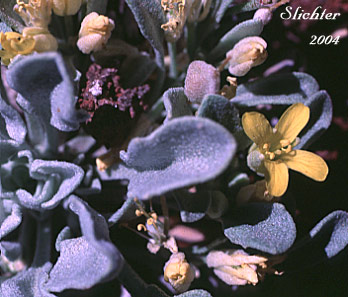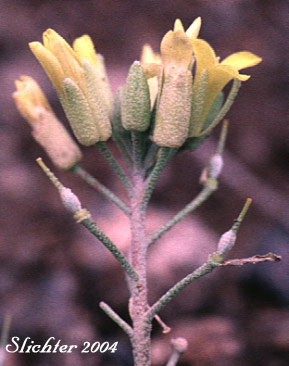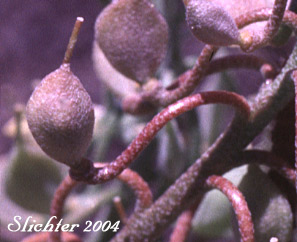
Synonyms: Lesquerella cusickii, Lesquerella occidentalis ssp. cusickii, Lesquerella occidentalis ssp. occidentalis, Lesquerella occidentalis var. cusickii, Lesquerella occidentalis var. occidentalis
 The
photo at right shows the flowers and young fruits of western bladderpod as seen
along road 8 south of Mitchell, OR.........May 24, 1998.
The
photo at right shows the flowers and young fruits of western bladderpod as seen
along road 8 south of Mitchell, OR.........May 24, 1998.
Western bladderpod is an attractive biennial to perennial wildflower of the intermountain west. It has several to many prostrate or ascending to erect stems rising 10-20 cm high from a cluster of many basal leaves. The leaves may be greenish, but are often covered with dense, silvery, star-shaped hairs (See photos of leaves on this page.). The basal leaves are long petiolate with broad, ovate to orbicular blades with entire margins or toothed edges. Some of the leaves may be pinnately lobed, with the terminal lobe broad and with several smaller, lateral lobes. The leaves range from 2-8 cm long and 5-22 mm wide. The 1-5 stem leaves are reduced in size and are narrowly oblanceolate in shape with entire margins.
The racemes are short at first bloom, but expand as fruit begin to form, the new blooms always clustered at the top. The flower pedicels range from 7-15 mm long and are straight in bloom but become S-shaped in fruit. The narrowly oblong sepals are 6-7 mm long while the yellow petals are 8-1o mm long. The fruits are narrowly elliptic to obovate silicles from 4-8 mm long. The style is 4-5 mm long. The fruits are densely covered with short, silvery star-shaped hairs and are moderately compressed parallel to the septum with thin margins.
Variety cusickii: Biennial. Base of plant lacking many persistent, old, withered leaves. Plants of mid elevation in the mountains of northeastern Oregon south to Nevada and Utah.
Variety diversifolia: Perennial. Base of plant with numerous persistent, old, withered leaves. The basal leaves are usually toothed or lobed and covered with grayish, star-shaped hairs. The stems are often ascending to erect and are generally over 10 cm long. Plants of dry, open areas from mid elevation in the mountains to the dry plains from northeastern Oregon and central Oregon south to California.
Variety occidentalis: Perennial. Base of plant with numerous persistent, old, withered leaves. The basal leaves have entire margins with greenish blades. Plants have prostrate stems generally less than 10 cm long. Found from southeastern Oregon and western Idaho to Nevada.
Western bladderpod may be found in dry soils, ranging from fine clays to rocky soils from the sagebrush covered valleys to rocky ridgetops and subalpine slopes in the mountains. It is often found on unstable, disturbed slopes such as road cuts.
Western bladderpod may be found east of the Cascade Mts. from central Oregon east to northeastern Oregon and southeastern Washington and east to Gilliam, Harney and Malheur counties in southeastern Oregon. It is found further east to central Idaho and south to California, Utah and Nevada.
